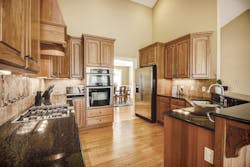Older adults are shaping up to be a hot remodeling market. One reason is the sheer number of them. The U.S. Census Bureau estimates that by 2030 the over-65 population will have grown from around 47 million in 2015 to more than 71 million. Another reason is that most of these people intend to stay put: According to the 2016 Aging-in-Place report from online lead generation site Home Advisor, 61 percent of people older than 55 intend to stay at home as long as possible.
Sounds promising, right? Remodelers who work with this population say yes, but also point out that “aging in place” includes two different niches requiring different skills.
Planning Ahead
The larger niche is universal design for working-age people. Any remodeler can take advantage of this, and many do. The National Association of Home Builders’ (NAHB) 2016 Remodeling Market Index found that 83 percent of its surveyed remodeler members include at least some universal design features in their projects.
“We always suggest universal design details to clients in their late 40s or older,” says Chicago-area remodeler and architect Michael Menn. Those details run the gamut from curbless showers to wider hallways and doors, to decorative grab bars, to backing bathroom drywall with plywood where clients may eventually want grab bars.
Some remodelers go even further. “My goal is always to try and make the main floor of the home [accessible] by someone with any limitation,” says Joseph Irons, of Irons Brothers Construction, in Seattle. He suggests barrier-free entries and prefers carefully landscaped walkways that slope to the front door; lever handles on doors and faucets; wheelchair-height counters; and a first-floor room than can serve as a bedroom. “My approach is to ask clients if they have friends or family who visit sometimes and who would benefit from wider doors or who have trouble getting up stairs,” he says, pointing out that a lot of people have an older parent they expect will eventually move in with them.
The more challenging aging-in-place work is what could be called adaptive remodeling (our second niche). It consists of home modifications for people with medical conditions that can range from hip replacements to dementia. Success here requires extra training, which is covered in certification programs from NAHB’s Certified Aging-in-Place Specialist (CAPS) program.
Established companies often end up doing this work for long-time customers. “Many remodelers have a deep client base they’ve been working with for years,” says Dan Bawden of Legal Eagle Contractors, a Houston company with 40 years’ experience. “Eventually they end up solving new age-related problems for those same clients.”
Then again, some remodelers just see an opportunity. “I saw a need and decided to learn as much as possible about it,” says Irons, who got CAPS certified in his late 20s and just turned 40. Today, half of his business is universal design and another 20 percent is adaptive work.
Get Professional Help
If you’re interested in adaptive work, be aware that it can be more intense than generic universal design. For one thing, with older or disabled clients, you may have to tactfully navigate uncomfortable medical and emotional issues. You need to understand what products and designs work in what situations, how to communicate with clients and family members, how to structure contracts, and how to limit liability.
The most basic part of that is learning to see the home through the lens of the client’s limitations. “You have to be aware of small things that might not otherwise seem important,” says Scott Sevon of remodeling firm MAW Chicago. These range from which side of a shower unit needs a built-in seat for a stroke victim, to which kitchen ranges are safe in a home for someone who has Alzheimer’s disease.
It’s easy to make big mistakes. Bawden has seen remodelers install curbless showers with glass partitions for older clients who have mobility issues—a recipe for disaster should the client lose balance and grab the edge of the glass for support.
To avoid such blunders, every CAPS-certified remodeler we interviewed had also worked with an occupational therapist, or OT, who understands home modifications. (The CAPS program has a list of certified OTs on its website.) The OT understands how people perform daily activities at different stages of life with various medical conditions and can evaluate products to determine their appropriateness for a particular client. OTs and remodelers who develop mutual trust often end up referring work to one another.
It’s not uncommon for the OT to be brought in as a design consultant. “My OT spends a couple of hours walking the house and asking the client to do things like stepping in and out of the tub or shower and reaching over counters,” Bawden says. The remodeler then gets a two-to-three page, single-spaced letter listing the items to be addressed, including where to install grab bars as well as the heights and depths of cabinets and countertops. “It usually ends up increasing my scope of work,” Bawden adds.
The OT will also address sensitive issues. “We can talk about very personal things that are more comfortably discussed with a health-care professional,” says Debra Young of EmpowerAbility, a Newark, Del.-based occupational therapist who works with remodelers. They’ll talk about toileting, for instance. “Part of the evaluation process is making sure the client can get on an off the toilet safely and independently,” Young says. “We break down the process and determine the most appropriate equipment and type of toilet for that person’s condition.”
It’s important to note that the remodeler is still liable for the installation. To reduce exposure, Bawden, who is an attorney as well as a remodeler, recommends that the OT work with and bill the customer directly. “Never treat the OT like a subcontractor, where you mark up the bill,” he cautions. “If something were to go wrong, a plaintiff’s lawyer could argue that your company was assuming responsibility.”
Adult children may worry about the remodeler depleting their inheritance address that by comparing the cost of the remodel with the cost of an assisted-living facility.
Watch What You Say
It’s a cliché to say that remodelers need good communication skills, but those skills are crucial in adaptive work. Helping clients with medical issues can mean crossing some emotional minefields. Empathy is part of the job description. “A client may have lived in the home for 30 years and raised children there,” says Steve Hoffacker, a CAPS trainer in West Palm Beach, Fla. “When the wallpaper and cabinets start coming down, it can be emotionally painful for some.”
The key is to get educated on the issues facing this population. For instance, the remodeler should accommodate older clients whose advanced age is usually accompanied by deteriorating eyesight. “When meeting with the client, make sure you have proper lighting and you’re not positioned with a bright light behind you,” Hoffacker says. Also, as people get on in years, their attention spans tend to shorten. “Be sensitive to this,” he says. “Know when to slow down and let clients process information, and know how to do it in a way that’s not condescending.”
Bawden finds that some elderly people who live alone will spend extended time talking with the remodeler during the project. He factors that extra time into the project cost. “I call it milk and cookies time,” he says.
Who’s in Charge?
When family members are involved, it’s important to figure out who the real decision maker is. For instance, adult children may be concerned about you spending their inheritance. You can address that by comparing the cost of the remodel with that of an assisted- or independent-living facility.
Sevon prefers that a family member is involved in the planning because older people often have issues with their memory. “You may recommend 12 lights in the stairwell but they opt for six, only to come back later asking why there aren’t 12,” he says. Having a family member review the specs helps eliminate such problems. And Bawden wants that adult child to actually sign the contract. “That way, if the deal goes sideways later on,” he says, “they can’t accuse you of taking advantage of their parents,” and if there’s a money issue, the child and parent will be jointly liable for payment.
When working for very old or ailing clients, Bawden also advises having an attorney craft a contract that ensures payment if the client dies before the project is complete. This usually puts payment responsibility on the estate.
The Bottom Line
Remodelers who have learned how to successfully navigate the adaptive remodeling niche say it can be a predictable source of good income. “We have all the work we can handle from people with money who want to renovate their homes so that mom can move in with them,” Bawden says. “This type of work actually carried us through the last slowdown. There’s a lot of demand for it.”
At the same time, the emotional and legal issues can be moving targets. CAPS training is a good start, but remodelers also need to budget time and money for continuing education. “You have to constantly reeducate yourself to stay ahead of the competition,” Sevon says. “If you can’t make that commitment, this niche isn’t for you.”
About the Author
Charlie Wardell
Charlie Wardell is a freelance writer and former remodeler in Tisbury, Mass.

